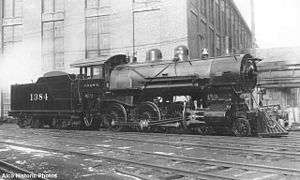Chicago and North Western class R-1
The Chicago and North Western Railway Class R-1 was a class of 325 American 4-6-0 locomotives. They were built between 1901 and 1908 by the Schenectady Locomotive Works and its successor, the American Locomotive Company; Baldwin Locomotive Works also built 85 of them.
| Chicago & North Western Railway Class R-1 | |||||||||||||||||||||||||||||||||
|---|---|---|---|---|---|---|---|---|---|---|---|---|---|---|---|---|---|---|---|---|---|---|---|---|---|---|---|---|---|---|---|---|---|
 C&NW 1384 in its 1907 builder's photo. | |||||||||||||||||||||||||||||||||
| |||||||||||||||||||||||||||||||||
| |||||||||||||||||||||||||||||||||
| |||||||||||||||||||||||||||||||||
| |||||||||||||||||||||||||||||||||
Design
The locomotives were an enlarged version of the class R. While both classes had 63-inch (1.600 m) diameter driving wheels and a cylinder stroke of 26 inches (660 mm), the R-1 had larger diameter cylinders – 20 to 21 inches (508 to 533 mm), a higher boiler pressure 190 to 200 lbf/in2 (1.31 to 1.38 MPa), and a larger firebox. They also had piston stead of slide valves, which made subsequent conversion to superheating easier.
The biggest change was in the firebox: the class R locomotives' firebox had been between the frames and only 40 1⁄4 inches (1,020 mm) wide. On the R-1 locomotives it was above the rear drivers and was not restricted by the gap between the frames (which was constrained by the track gauge). Consequently, the 64 1⁄4-inch (1,630 mm) wide firebox gave 60 percent larger grate area – both classes had fireboxes 102 inches (2,600 mm) deep.
Most locomotives had Stephenson valve gear, except for the 1908 batch, which had Walschaerts.[1]
Construction
The locomotives were built by Schenectady Locomotive Works and by the same works under its corporate successor, the American Locomotive Company. Baldwin Locomotive Works also built 85 of the locomotives; Baldwin marked them as 10-36 D in their classification system.
| Year | Quantity | Manufacturer | Serial numbers | C&NW numbers | Notes |
|---|---|---|---|---|---|
| 1901 | 16 | Schenectady | 5844–5859 | 168/78, 287/89–91/95, 896, 910–12/22/39, 1041/42 | |
| 1901 | 4 | Schenectady | 6206–6209 | 160, 594–596 | |
| 1902 | 14 | Alco | 25397–25410 | 1066–1079 | |
| 1902 | 9 | Alco | 26530–26538 | 1102–1110 | |
| 1903 | 14 | Alco | 27581–27594 | 1111–1124 | |
| 1903 | 45 | Baldwin | 22509/19/39/40/63/67/68/76, 22624/25, 22701/18/58/65/73/80, 22818/24/35/43/61/64/86, 22909/35/36/50/71/94, 23004/25/32/67/68/83/84/94, 23102/16/17/25/34/55/84, 23217 | 1125–1169 | |
| 1905 | 18 | Alco | 30229–30316 | 76, 416/41/51/54/66/78/76/81/83, 236/37, 479, 916/17, 462/63 | |
| 1905 | 15 | Alco | 30595–30609 | 469–474/80/84–91 | |
| 1906 | 30 | Alco | 38513–38542 | 411–14/17/18/22–25/29/40/42/44–49, 899, 915/23/24, 1219–1222/29–31 | |
| 1906 | 35 | Alco | 39121–39246 | 1333–1367 | |
| 1907 | 30 | Baldwin | 31547–49/59–62/85–88, 31618–23/73/87/88, 31734/45–47/84, 31830/55/56/84, 31914 | 18, 29, 38, 44, 50, 61, 62, 122/59/61/82/84/85, 245, 343–45/48/49/59/60, 452, 555, 925/34–38/60 | |
| 1907 | 30 | Alco | 42170–42199 | 1368–1397 | |
| 1907 | 30 | Alco | 42399–42428 | 1398–1427 | |
| 1908 | 10 | Baldwin | 32567/74/94, 32602–04/26/45/60/61 | 1323–1332 | |
| 1908 | 25 | Alco | 45726–45750 | 172/75, 375–80/82/83/8586/88, 406/50/53/55–58, 893/94, 926/27/52 |
Service
The Class R-1 was designed for freight service, and initially was used that way. As train weights rose and more powerful locomotives were acquired, they were cascaded down to branch line and mixed train service.
Several were converted to oil firing—at least 87 locomotives are known to have run as oil-burners at some point in their C&NW service.[3]
From the 1920s onwards, several locomotives had superheaters installed; some of them having new boilers of a slightly larger design.
Retirements started in 1929, but the last was not retired until 1956.
| Year | Quantity in service at start of year | Quantity scrapped | Numbers | Notes |
|---|---|---|---|---|
| 1929 | 325 | 1 | 1132 | |
| 1936 | 324 | 4 | 476, 1130/61, 1359 | |
| 1937 | 320 | 6 | 184, 360, 1102/11/31/67 | |
| 1938 | 314 | 1 | 893 | |
| 1939 | 313 | 12 | 168, 382, 425/49/83, 1077, 1110/12/16/63, 1229, 1395 | |
| 1940 | 301 | 26 | 245, 375/80, 417/23/51/71/91, 960, 1120/36/38/45/64/66, 1336/45/47–49/57/69/75/93/99, 1421 | |
| 1941 | 275 | 7 | 185, 424, 896, 1219, 1334/64/67 | |
| 1942 | 268 | 1 | 1392 | |
| 1943 | 267 | 3 | 1137, 1382, 1420 | |
| 1944 | 264 | 19 | 418/47/80, 1041/42/74, 1104/14/39/41/43, 1328/35/61/63/65/97, 1411/24 | |
| 1945 | 245 | 7 | 182, 921, 1126, 1339/51/70, 1416 | |
| 1946 | 238 | 7 | 290, 452/66, 915, 1106/47, 1405 | |
| 1947 | 231 | 18 | 44, 61, 122, 295, 343, 484/85, 596, 1070/76/78, 1105/50, 1327/33/55/88/91 | |
| 1948 | 213 | 1 | 1406 | First half-year only |
Preservation
Three locomotives have been preserved:[5]
- CNW 175 (Alco 45272 of 1908) under restoration at the Steam Railroading Institute, Owosso, Michigan;
- CNW 444 (Alco 38526 of 1906) on display at the Forney Transportation Museum, Denver, Colorado;
- CNW 1385 (Alco 42187 of 1907) under restoration at the Mid-Continent Railway Museum, North Freedom, Wisconsin.
References
- Cole 1938, p. 74.
- Cole 1938, pp. 17–62.
- Cole 1938, p. 63.
- Chicago and North Western Railway 1948, pp. 3–19.
- Barrie, Wes. "4-6-0 locomotives in the USA". steam locomotive.com. Retrieved 2019-07-07.
General references
- Cole, F.A. (1938). Locomotives of the Chicago & North Western Railway. Boston: The Railway & Locomotive Historical Society.CS1 maint: ref=harv (link)
- Chicago and North Western Railway (1948). Locomotives of the Chicago & North Western Railway, supplement. The Railway & Locomotive Historical Society.CS1 maint: ref=harv (link)
- Drury, George H. (1985). The Historical Guide to North American Railroads. Milwaukee, Wisconsin: Kalmbach Publishing Company. ISBN 0-89024-072-8. LCCN 85080107.
- Barrie, Wes. "C&NW 4-6-0 loomotives". steamlocomotive.com. Retrieved 2019-07-07.